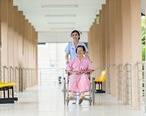Sun Safety During Covid
As the pandemic continues to dominate our conversations about safety, we can’t afford to forget about the other, older risks that haven’t gone away.

The summer weather has drawn many Americans outside—to parks, beaches, sidewalks, and even outdoor dining venues. One study found that the odds of covid-19 transmission are almost 19 times higher indoors as compared to outdoors, and so expert advice has been that venturing outside, while keeping a distance and wearing a mask, is a safe way to escape the rooms and houses that have come to feel confining after months of quarantine. Even for older adults and others at particularly high risk, the outdoors have become a safe and healthy outlet.
But as the pandemic continues to dominate our conversations about safety, we can’t afford to forget about the other, older risks that haven’t gone away. July just so happens to be Ultraviolet (UV) Safety Awareness Month—a designation which is only necessary because hundreds of thousands of people every year put themselves in harm’s way by too eagerly soaking up the summer sun’s rays. For older adults, the risks are particularly high. In 2017, the National Institute of Health went so far as to call the rising rates of melanoma, which is one particularly dangerous form of skin cancer, an epidemic. As you go outside and take advantage of the warm weather, be sure to not to let the focus on covid-19 eclipse precautions against this more commonplace, but equally dangerous disease.
Fortunately, unlike the novel coronavirus, scientists already know a whole lot about UV rays, skin cancer, and how to keep ourselves safe from them. Unfortunately—as we’ve seen with covid-19—not everyone listens to their advice. But even for those who are generally quite attentive, there’s a lot more to know about skin cancer than most people are aware of. There’s more to it than just sunscreen and shade.
One thing few people know about skin cancer is that while the disease is most common among people with low levels of melanin, outcomes tend to be far worse among people of color, often because it is caught farther along. Not only do people of color and their doctors tend to be less wary of this risk due to its lower incidence, and thus less likely to check for it, but they also tend to develop it in more discrete spots like the bottoms of their feet, where it can more easily go unnoticed.
It’s also worth keeping in mind that UV rays reach us on cold and cloudy days, not just sunny and hot ones. 1 in 5 Americans develop skin cancer by the age of 70, and more than two Americans die from skin cancer every hour—which is less than the coronavirus at the moment, but nevertheless a frightening rate. Given that doctor’s visits are harder to attend safely these days, it is especially important to check for unusual spots on your own. When caught early, skin cancer is highly treatable.
As many of us know, spending time outside has countless benefits, pandemic or no pandemic. But now more than ever, it’s important to find ways to be active and able to enjoy the outdoors—while bearing in mind that the coronavirus is not the only health risk to consider.














There are no comments for this article yet. Be the first to leave a comment